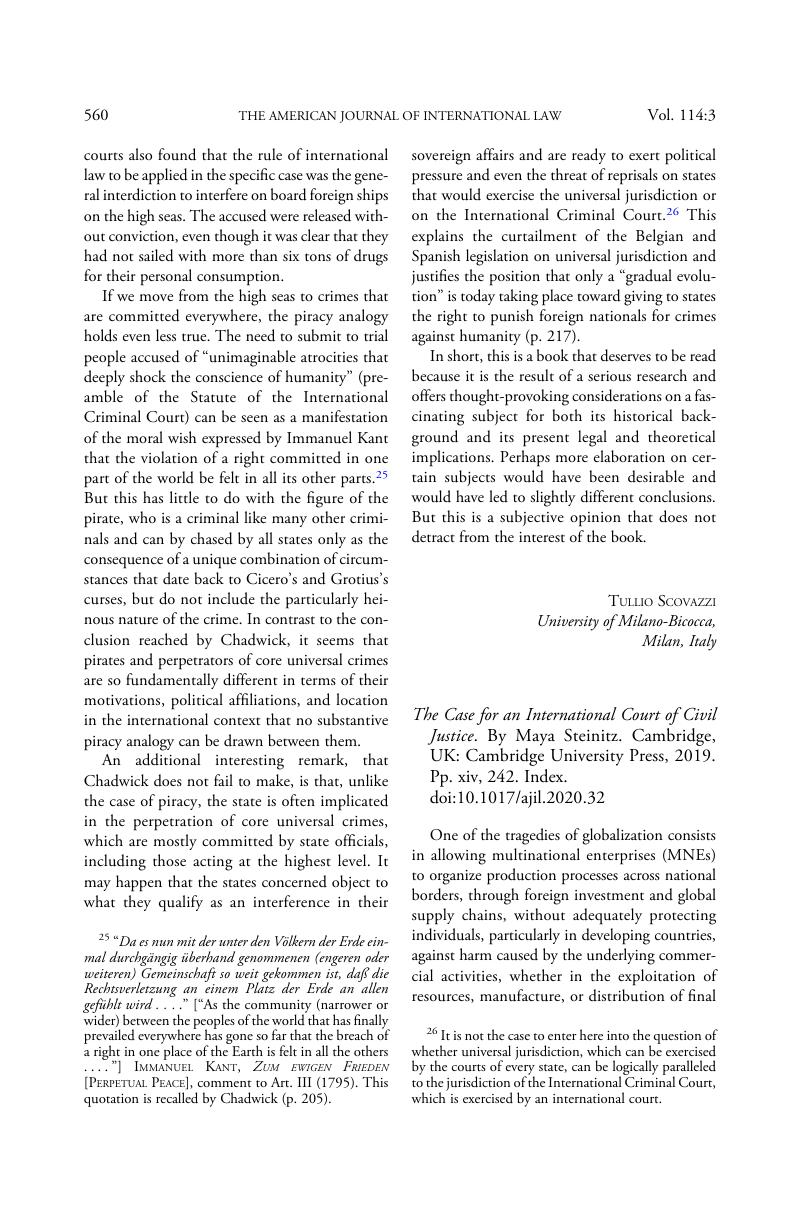No CrossRef data available.
Published online by Cambridge University Press: 17 July 2020

1 For a classic overview, see Peter Muchlinski, Multinational Enterprises & the Law (2d ed. 2007).
2 See Sauvant, Karl P., The Negotiations of the United Nations Code of Conduct on Transnational Corporations: Experience and Lessons Learned, 16 J. World Inv. & Trade 11 (2015)Google Scholar.
3 For a recent assessment of the OECD Guidelines, see the contributions in 40 ans des lignes directrices de l'OCDE pour les entreprises multinationales [40 Years of the OECD Guidelines for Multinational Enterprises] (Nicola Bonucci & Catherine Kessedjian eds., 2018).
4 See UN Human Rights Council, Report of the Special Representative of the Secretary-General on the Issue of Human Rights and Transnational Corporations and Other Business Enterprises, John Ruggie, Annex, UN Doc. A/HRC/17/31 (Mar. 21, 2011). See further The UN Guiding Principles on Business and Human Rights: Foundations and Implementation (Radu Mares ed., 2012).
5 For the most recent draft, see Open-Ended Intergovernmental Working Group on Transnational Corporations and Other Business Enterprises with Respect to Human Rights, Legally Binding Instrument to Regulate, in International Human Rights Law, the Activities of Transnational Corporations and Other Business Enterprises (rev. draft, July 16, 2019), available at www.ohchr.org/Documents/HRBodies/HRCouncil/WGTransCorp/OEIGWG_RevisedDraft_LBI.pdf.
6 See, e.g., Surya Deva, Regulating Corporate Human Rights Violations – Humanizing Business (2012); John Ruggie, Just Business – Multinational Corporations and Human Rights (2013); Law, Business and Human Rights – Bridging the Gap (Robert C. Bird, Daniel R. Cahoy & Jamie Darin Prenkert eds., 2014); The Business and Human Rights Landscape – Moving Forward, Looking Back (Jena Martin & Karen E. Bravo eds., 2015); Nadia Bernaz, Business and Human Rights: History, Law and Policy – Bridging the Accountability Gap (2016); Business and Human Rights: From Principles to Practice (Dorothée Baumann-Pauly & Justine Nolan eds., 2016); Building a Treaty on Business and Human Rights: Context and Contours (Surya Deva & David Bilchitz eds., 2017); Dalia Palombo, Business and Human Rights: The Obligations of the European Home States (2020).
7 See, e.g., Markos Karavias, Corporate Obligations Under International Law (2013); Human Rights Obligations of Business Beyond the Corporate Responsibility to Respect? (Surya Deva & David Bilchitz eds., 2013). For a critical account from a theoretical perspective, see also Samantha Besson, The Bearers of Human Rights’ Duties and Responsibilities for Human Rights: A Quiet (R)Evolution?, 32 Soc. Phil. & Pol'y 244 (2015).
8 See Nowak, Manfred, The Need for a World Court of Human Rights, 7 Hum. Rights L. Rev. 251 (2007)Google Scholar; Julia Kozma, Manfred Nowak & Martin Scheinin, A World Court of Human Rights: Consolidated Statute and Commentary (2010).
9 The ICCJ would be different from a human rights court in that it is aimed at producing civil law judgments providing for monetary compensation for harm done and would not be called to review the conformity of the applicable domestic legal framework, or any state measures taken in that respect, with international human rights law. The ICCJ would thus also not be part of the judicialization of human rights law.
10 For the main litigation in U.S. courts related to the Bhopal disaster, see In re Union Carbide Corp., 634 F. Supp. 842 (S.D.N.Y 1986) and 809 F.2d 195 (2d Cir. 1987).
11 For the main litigation in U.S. courts, see Aguinda v. Texaco, Inc., 303 F.3d 470 (2d Cir. 2002).
12 See Kiobel v. Royal Dutch Petroleum Co., 569 U.S. 108 (2013).
13 For the French legislation, see Loi 2017-399 du 27 mars 2017 relative au devoir de vigilance des sociétés mères et des entreprises donneuses d'ordre 2017 (JORF) 2017–399. For comparative analysis of the situation in France, the United Kingdom, and Switzerland, see Palombo, Dalia, The Duty of Care of the Parent Company: A Comparison Between French Law, UK Precedents and the Swiss Proposals, 4 Bus. & Hum. Rts. J. 265 (2019)Google Scholar.
14 The principle of autonomy of European Union (EU) law could be one such constitutional limitation for EU member states. See CJEU, Opinion 1/19 (8 March 2011) ECR 2011, I-1137 – European and Community Patents Court. Other constitutional law principles, such as the principle of democratic governance, governance according to the rule of law, or the protection of fundamental and human rights could equally pose limits to the creation of international court. See, e.g., German Constitutional Court [Bundesverfassungsgericht], Case No 2 BvR 739/17, Decision of 13 February 2020, ECLI:DE:BVerfG:2020:rs20200213.2bvr073917, paras. 103–40, available at www.bundesverfassungsgericht.de/e/rs20200213_2bvr073917.html.
15 See, e.g., Pauwelyn, Joost, WTO Dispute Settlement Post 2019: What to Expect?, 22 J. Int'l Econ. L. 297 (2019)CrossRefGoogle Scholar; Vidigal, Geraldo, Living Without the Appellate Body: Multilateral, Bilateral and Plurilateral Solutions to the WTO Dispute Settlement Crisis, 20 J. World Inv. & Trade 862 (2019)Google Scholar.
16 Pauwelyn, supra note 15, at 312–15.
17 See The Hague Rules on Business and Human Rights Arbitration (Dec. 2019), available at www.cilc.nl/cms/wp-content/uploads/2019/12/The-Hague-Rules-on-Business-and-Human-Rights-Arbitration_CILC-digital-version.pdf.
18 See in particular Armin von Bogdandy & Ingo Venzke, In Whose Name? A Public Law Theory of International Adjudication (2014); International Judicial Lawmaking – On Public Authority and Democratic Legitimation in Global Governance (Armin von Bogdandy & Ingo Venzke eds., 2014); The Legitimacy of International Trade Courts and Tribunals (Robert Howse, Hélène Ruiz Fabri, Geir Ulfstein & Michelle Q. Zang eds., 2018). See also Romano, Cesare P. R., Essay, Review, Legitimacy, Authority, and Performance: Contemporary Anxieties of International Courts and Tribunals, 114 AJIL 149 (2020)CrossRefGoogle Scholar.
19 For the relevant documents, see the website of UNCITRAL Working Group III, at https://uncitral.un.org/en/working_groups/3/investor-state.
20 See UNCITRAL, Report of Working Group III (Investor-State Dispute Settlement Reform) on the Work of Its Thirty-Sixth Session, paras. 40, 53, 63, 83, 90, 98, 108, 123, 127, 133, UN Doc. A/CN.9/964 (Nov. 6, 2018).
21 See Roberts, Anthea, Incremental, Systemic, and Paradigmatic Reform of Investor-State Arbitration, 112 AJIL 410 (2018)CrossRefGoogle Scholar; Schill, Stephan W. & Vidigal, Geraldo, Designing Investment Dispute Settlement à la Carte: Insights from Comparative Institutional Design Analysis, 18 L. & Prac. Int'l Cts. & Tribs. 314 (2019)Google Scholar.